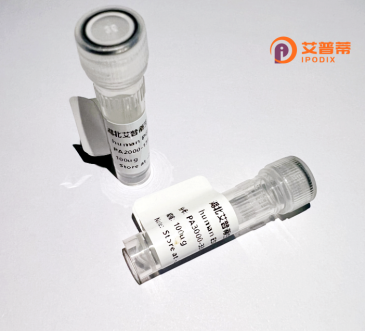
| 纯度 | >95%SDS-PAGE. |
| 种属 | Human |
| 靶点 | SLC3A2 / CD98 |
| Uniprot No | P08195 |
| 内毒素 | < 0.01EU/μg |
| 表达宿主 | E.coli |
| 表达区间 | 206-630aa |
| 氨基酸序列 | RAPRCRELPAQKWWHTGALYRIGDLQAFQGHGAGNLAGLKGRLDYLSSLK VKGLVLGPIHKNQKDDVAQTDLLQIDPNFGSKEDFDSLLQSAKKKSIRVI LDLTPNYRGENSWFSTQVDTVATKVKDALEFWLQAGVDGFQVRDIENLKD ASSFLAEWQNITKGFSEDRLLIAGTNSSDLQQILSLLESNKDLLLTSSYL SDSGSTGEHTKSLVTQYLNATGNRWCSWSLSQARLLTSFLPAQLLRLYQL MLFTLPGTPVFSYGDEIGLDAAALPGQPMEAPVMLWDESSFPDIPGAVSA NMTVKGQSEDPGSLLSLFRRLSDQRSKERSLLHGDFHAFSAGPGLFSYIR HWDQNERFLVVLNFGDVGLSAGLQASDLPASASLPAKADLLLSTQPGREE GSPLELERLKLEPHEGLLLRFPYAAVDHHHHHH |
| 预测分子量 | 48 kDa |
| 蛋白标签 | His tag N-Terminus |
| 缓冲液 | PBS, pH7.4, containing 0.01% SKL, 1mM DTT, 5% Trehalose and Proclin300. |
| 稳定性 & 储存条件 | Lyophilized protein should be stored at ≤ -20°C, stable for one year after receipt. Reconstituted protein solution can be stored at 2-8°C for 2-7 days. Aliquots of reconstituted samples are stable at ≤ -20°C for 3 months. |
| 复溶 | Always centrifuge tubes before opening.Do not mix by vortex or pipetting. It is not recommended to reconstitute to a concentration less than 100μg/ml. Dissolve the lyophilized protein in distilled water. Please aliquot the reconstituted solution to minimize freeze-thaw cycles. |
1. **"Structural basis for amino acid exchange by a heteromeric amino acid transporter"**
- 作者:Kaihara, K., et al.
- 摘要:通过X射线晶体学解析了SLC3A2/CD98与SLC7A5形成的异源二聚体结构,揭示了其介导氨基酸转运的分子机制,为研究重组蛋白的底物识别提供了结构基础。
2. **"CD98hc facilitates oncogenic Ras signaling in pancreatic cancer"**
- 作者:Cantor, J.M., et al.
- 摘要:研究显示,重组CD98蛋白通过与整合素β1结合,激活下游Ras信号通路,促进胰腺癌细胞的增殖和侵袭,表明其在肿瘤进展中的关键作用。
3. **"CD98 heavy chain is a potent regulator of amino acid transporter function and macrophage activation"**
- 作者:Hassan, N., et al.
- 摘要:利用重组CD98蛋白验证其调控巨噬细胞中氨基酸转运的能力,并发现其通过mTORC1通路影响免疫细胞的代谢重编程及炎症反应。
4. **"Recombinant CD98 promotes cell-cell fusion through regulation of integrin signaling"**
- 作者:Fenczik, C.A., et al.
- 摘要:通过体外重组实验证明,CD98与整合素相互作用可增强细胞黏附和膜融合能力,为研究其在发育和病理状态中的功能提供依据。
SLC3A2 (solute carrier family 3 member 2), also known as CD98 or 4F2hc, is a multifunctional transmembrane protein that plays critical roles in amino acid transport, cell adhesion, and intracellular signaling. It serves as the heavy chain component of heterodimeric amino acid transporters, pairing with various light chains (e.g., LAT1. LAT2. y+LAT1) to form system L, y+L, or asc transporters. This partnership enables the uptake of essential neutral, cationic, and large neutral amino acids, linking cellular metabolism to growth signals through mTOR pathway activation.
Originally identified as a lymphocyte activation antigen (CD98), it is highly expressed in proliferating cells, including activated immune cells and cancer cells. Its dual functions include facilitating integrin-mediated cell adhesion and fusion processes, particularly in placental development and osteoclast activity. The extracellular domain of SLC3A2/CD98 contributes to cell-cell interactions, while its transmembrane domain anchors the light chain transporters.
Recombinant SLC3A2/CD98 proteins are engineered to study its structural and functional properties, often used in ligand-receptor interaction assays, antibody development, and mechanistic studies of amino acid transport. In therapeutic contexts, CD98 is investigated as a target for cancer immunotherapy due to its overexpression in tumors and role in supporting cancer cell proliferation. Additionally, its involvement in autoimmune diseases and viral entry mechanisms has spurred research into inhibitory antibodies or small molecules.
Produced typically in mammalian expression systems, recombinant CD98 retains post-translational modifications crucial for its native conformation and binding capabilities. Research applications span from elucidating amino acid dysregulation in metabolic disorders to developing diagnostic tools for malignancies. Its intersection of metabolic and adhesive functions continues to make SLC3A2/CD98 a compelling subject in both basic and translational biomedical research.
×